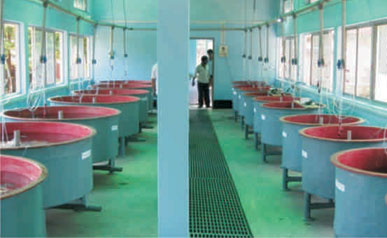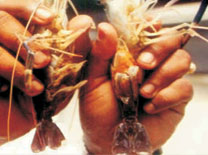
-
Giant freshwater prawn, Macrobrachium rosenbergii has vast potential for its culture in both maritime as well as inland states including North Eastern States. Desired quantity of quality seeds at desired time is one of the major constraints for expansion of prawn farming particularly in the inland states. Giant freshwater prawn needs 12 ppt saline water to complete its life cycle. The requirement of saline water hampers the establishment of giant prawn hatcheries in the inland states. Keeping in view of this, CIFE, Mumbai has developed a hatchery technology using artificial sea water for the use in inland states.
Description of technologyIn order to meet the requirement of saline water for completion of life cycle of giant fresh water prawn, a chemical formula was prepared with six major, six minor and six trace salts to prepare artificial sea water. Since most of the minerals and trace salts are available in natural freshwater, a simple formula with seven major salts was prepared. Initially, laboratory grade chemicals were used for preparation of artificial sea water. Keeping in view of the economic feasibility of the technology, commercial grade salts were used for the preparation of artificial saline water of 12 ppt. In order to prepare artificial sea water desired quantity of filtered fresh water was filled in a thoroughly cleaned tank. Size of the tank and volume of water depends on the production capacity of hatchery. After filling the water, desired quantity of various salts was calculated, weighed and kept ready. The salts were mixed one after other with thorough aeration and kept for 2-3 days with aeration.
Then the water was filtered and used for the operation of giant fresh water prawn hatchery. The hatchery operation is same as that followed in the natural sea water hatchery. The hatchery can be operated by following either flow through or recirculatory system. In flow through system, in order to use water economically the siphoned water is collected in a separate tank for treatment and reused in the hatchery operation. Supernatant water from used water tank is pumped into a separate tank provided with biological filter attached to recirculatory system for a period of one week. This helps in removal of ammonia and nitrite from the used water. This water can be used in regular hatchery operation. If water quality is maintained properly, the same water can be used for a period of 3 years or even more with salinity adjustment by adding freshwater, if necessary. Technology benefits
Technology benefitsThe establishment of prawn hatcheries in the inland states will help in production of quality seeds locally and enhance the productivity which in turn improves the socioeconomic status of farmers and entrepreneurs. Various government and semi-government organizations, NGOs, entrepreneurs and farmers can get benefit out of this technology.
Commercialization statusThe technology has been demonstrated on experimental scale in Maharashtra, Madhya Pradesh, Uttar Pradesh, Assam, Karnataka, Orissa, Kerela, Andhra Pradesh and West Bengal. Giant freshwater prawn hatcheries using artificial sea water have been established in Tripura, Chattishgarh, Madhya Pradesh, Nagaland and Manipur. MoU has been signed between Department of Fisheries, Government of Assam and CIFE, Mumbai for the establishment of three prawn hatcheries in Assam. One hatchery has been established in Guwahati and the other two hatcheries are under construction at Silchar and Dubri. Another proposal is also in progress for the establishment of a giant freshwater prawn hatchery in Bihar and Uttar Pradesh.
